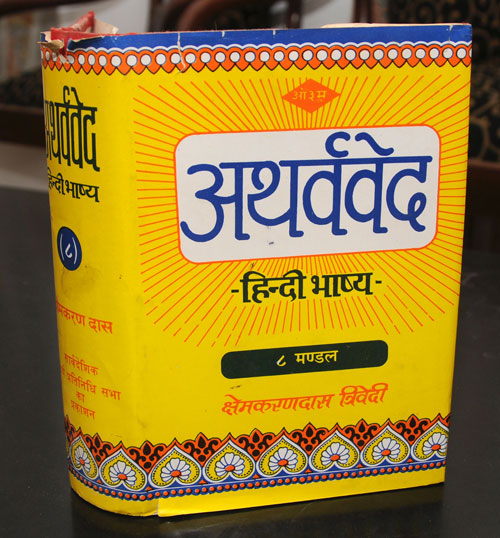Vedas & urethral strictures
As long ago as 3000 to 1000 BC, medical writings appeared as part of Indian religious hymns called Vedas.
Atharva Veda

The first reference to urological disease is found in the Atharva Veda (pictured) and it deals with urinary retention.
The core text dates from the end of the 2nd millennium BC, corresponding to the 12th to 10th centuries BC.
View the core text of the Atharva Veda
The book discusses the management of urinary retention with camphor, and with herbs to be rubbed onto the abdomen, along with chanting of the appropriate hymns. It also contains a number of recommendations for the alleviation of sexual dysfunction; along with more hymns, certain herbal roots were also to be taken in boiled milk to enhance sexual vigour.
Around the 9th century BC, known as the Samhita period, two important figures emerged:
Charaka (a ohysician) Susruta (a surgeon)
 Charaka Samhita
Charaka Samhita
The works of Charaka, called the Charaka Samhita, detail contemporary medicine in eight volumes. The fourth chapter of Volume Two is devoted to urinalysis and clinical interpretations based upon the color, consistency, turbidity, stickiness, presence of blood, semen, pus and fat in urine. Diagnosis also took into account symptoms such as frequency, dysuria, polyuria, fever, malaise or nausea. He also discusses urinary retention precipitated by dietary and alcoholic indiscretions.
There are long discussions on sexuality and erectile dysfunction. Twelve varieties of aphrodisiacs are categorized by age and specific complaints of quality of erection, maintenance of erection and premature ejaculation. Charaka advised abstinence until age 16 and after age 70.
Charaka describes symptoms of frequency, strangury, haematuria and urinary obstruction from vesical calculus. He mentions the shape and surface characteristics of various calculi and offers his theories on the aetiology. Various herbal medications are recommended for oral intake as well as to be anointed on the abdomen. In recalcitrant situations, he advised referral for surgical intervention.
 Susruta Samhita
Susruta Samhita
The great Indian surgeon Susruta was contemporary to Charaka, living sometime around 600 to 1000 BC. Susruta wrote a treatise of surgery called the Susruta Samhita, said to be the earliest oral rendition of a systematic teaching of surgery.
He discussed various urological diseases, their pathogenesis and management. He describes urethral probes, dilators and irrigating syringes for instillation of medications. On the management of urethral stricture (Niruddhaprakasha in Sanskrit), his treatment recommendations are:
A tube open at both ends made of iron, wood or shellac should be lubricated with clarified butter and gently introduced into the urethra. Thicker and thicker tubes should be duly introduced every 3rd day. The urethra passage should be made to dilate in this manner and emollient food should be given to the patient. As an alternative, an incision should be made into the lower part of the penis avoiding the raphe and it should be treated as an incidental ulcer
Susruta also devoted a chapter to penile sores. Treatments included scarification, coring, excision of condylomatous growths, local astringents and application of leeches.
← Back to Time Corridor